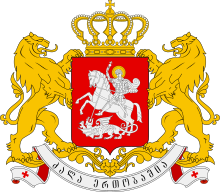Patronages of Saint George
An 18th-century Georgian geographer and historian Vakhushti Bagrationi wrote that there are 365 Orthodox churches in Georgia named after Saint George, according to the number of days in one year.The terms Georgia and Georgians appeared in Western Europe in numerous early medieval annals, gradually replacing the ancient exonyms of Iberia and Iberians.The feast day in November was instituted by St Nino of Cappadocia, who was credited with bringing Christianity to the land of Georgia in the 4th century.The Pshavs and Khevsurs during the Middle Ages used to refer to Saint George almost as much as praying to God and the Blessed Virgin Mary.The shepherd became angry at Jesus and told him that he is the one who takes the souls away of young men and grants long lives to many dishonest people.Edward dedicated the chapel at Windsor Castle to the soldier saint who represented the knightly values of chivalry which he so much admired, and the Garter ceremony takes place there every year.In the 16th century, Edmund Spenser included St. George (Redcross Knight) as a central figure in his epic poem The Faerie Queene.With the revival of Scottish and Welsh nationalism, there has been renewed interest within England in Saint George, whose memory had been in abeyance for many years.The city of Salisbury holds an annual St George's Day pageant, the origins of which are believed to go back to the 13th century.[15] His feast date, 23 April, is one of the most important holidays in Catalonia, where it is traditional to give a present to the loved one; red roses for women and books for men.Apparently, the English crusaders who helped King Afonso Henriques (1109–85) in the conquest of Lisbon in 1147 introduced a devotion to Saint George to Portugal.In the religious traditions of the Afro-Brazilian Candomblé and Umbanda, Ogum (as this Yoruba divinity is known in the Portuguese language) is often identified with Saint George in many regions of the country, being widely celebrated by both religions' followers.The cult, as in Lithuania, displaced that of a pagan deity, the sun god Dazhbog, which involved shepherds bringing their flocks to pastures.The historical Saint George's Monastery in Meshtaye village near the city of Homs is a Greek Orthodox religious complex dating back to the 5th century.At Mughni (Armenia), there is a monastery dedicated to Saint George, in Armenian Սուրբ Գեւորգ (Surb Gevork).One of Montenegro's islands is called Sveti Đorđe (Serbian Cyrillic: Свети Ђорђе), where there is a monastery devoted to the saint.Abbot Hatto (888–913) of the Monastic Island of Reichenau had a St George's Church erected, after he had received relics from the hands of Pope Formosus.The later Archbishop of Mainz made a major contribution to spread the veneration of Saint George throughout East Francia.On the banks of the Kodoor River in the district of Kottayam in Kerala, the village of Puthupally is known for its 16th-century St. George Orthodox Syrian Church.It is one of the largest pilgrim centers of Saint George in India, where they celebrate his feast on the first Saturday and Sunday in May.[29] In Lebanon, Saint George is believed to have cleaned off his spear at a massive rocky cave running into the hillside and overlooking the Jounieh Bay.In the heart of the city, a reconstitution (known as the "Combat dit Lumeçon") of the fight between Saint George and the dragon is played by 46 actors.He also appears on the coats of arms of several German towns and cities, including Bamberg, Bürgel, Dießen am Ammersee, Eisenach, Mengeringhausen, Schwarzenberg, and, of course, Sankt Georgen im Schwarzwald.For most of Lithuania's modern history, the day was celebrated by farmers with offerings of animals in churches and the baking of special bread.[36] Today several Lithuanian towns, including Marijampolė, Prienai and Varniai, display Saint George on their coats of arms.













St George's Church (disambiguation)Byzantine and Christian MuseumAthensMegalomartyrAnglicanismEastern OrthodoxyLutheranismOriental OrthodoxyRoman CatholicismUmbandaDruze faithPatronagearcherslepers and leprosysyphilisEnglandWesternEasternChristianSaint Georgepatronagescoats of armsAlaverdi MonasteryGeorgiaVakhushti Bagrationiback-derivationJacques de VitrySir John Mandevillefeast daySt NinoCappadociamartyrdomcoat of arms of GeorgiaGeorgian Orthodox ChurchKakhetiKhevsuretiMiddle AgesBlessed Virgin MaryMtiuletiJesus ChristgiorgiGeorgeWorld War INorman ConquestDurham CathedralmartyrologyFordingtonThetfordNorfolkDoncasterCrusadersHoly LandSt DemetriusSt MauriceEdward IIIknighthoodOrder of the Garterpatron saintSaint EdmundEdward the ConfessorchapelWindsor CastlechivalryEdmund SpenserThe Faerie QueeneWilliam ShakespeareHenry VRichard IIIKing LearSt. George and the DragonNational Gallery of ArtScottishSt George's flagsUnion FlagsPalace of WestminsterBig BenFlag of EnglandLondonHouses of ParliamentSir Edward John PoynterSt George and the DragonSt George's DayGreater London AuthoritySalisburyOrder of St Michael and St GeorgeCrown of Aragonautonomous communitiesAragonCataloniaValenciaBalearic IslandsBarcelonaFlag of BarcelonaCáceresSpanish languageCatalan languageAragonese languagemost important holidays in Catalonia'National Day of Aragon'Castile and LeonRevolt of the ComunerosSt. George CastleLisbonPortugalAfonso HenriquesAfonso IVbattle crySaint JamesNuno Álvares PereiraSaint Constablebattle of AljubarrotaJohn ICorpus ChristiPortuguese EmpireBrazilAfro-BrazilianCandombléYorubaPortuguese languageRio de JaneiroSaint SebastianfootballCorinthiansSão PauloParque São JorgeSozopol

